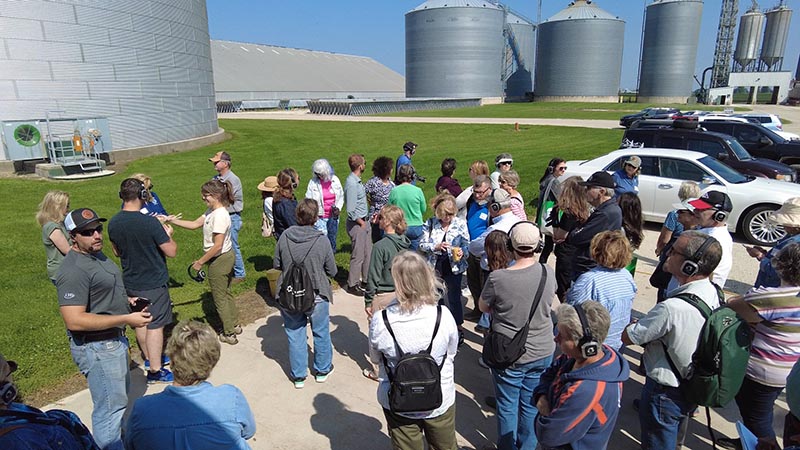Participants of the Chicago Wilderness Alliance 2023 Kane County Farm Tour visit CHS Elburn.
Maggie Soliz recently came face-to-face with agricultural diversity in her native Kane County. Located 45 miles west of downtown Chicago, Kane County is a model for proactive land use planning. Voluntary farmland preservation conservation easements are among tools used to strike a balance between the needs of the county’s urban and rural communities.
Soliz is the product of the old Fox River towns on the east edge of Kane County. She grew up in St. Charles, raised a family in Batavia, and then spent 20 years brokering the sale of farms to developers.
A passion for wildflowers turned into a second career in prairie conservation. She was elected to the board of the Kane-DuPage Soil and Water Conservation District, and is now also treasurer of Association of Illinois Soil and Water Conservation Districts.
She’s also a member of the Growing with Agriculture Committee for the Chicago Wilderness Alliance. This four-state regional consortium of natural land advocates seeks common ground with farmers to implement landscape-scale approaches to conservation in and around the southern shores of Lake Michigan.

The Alliance’s second annual agriculture field day enabled Soliz to get acquainted with Olivia Winters.
A 2023 graduate of Olivet Nazarene University in Kankakee County, Winters studied conservation biology and landed her first job with the Illinois Agroecology + Innovation Matters (AIM) initiative.
Winters is one of the Capacity Building Initiative’s 40 conservation planners spread across the state’s NRCS field offices. She is based at the St. Charles office, not far from where she grew up in the Cook County suburb of Bartlett.
Winters and Soliz spent time together that day on the tour. Two buses traveled the back roads through the outskirts of metropolitan Chicago, opening riders’ eyes to Kane County’s agriculture heritage – and future.
Several dozen folks met that morning at the Kane County Farm Bureau. The tour started with KCFB’s Illinois Prairie Pollinator Rain Garden, and included everything from an organic wildflower farm to a CHS Elburn grain elevator surrounded by corn and soybean fields. (This “Bounty of Kane” guidebook lists 37 direct-to-retail farmers and the many farmers markets.)
Soliz and Winters came away energized and as new friends. What binds the novice and her mentor is their local roots and, especially, their shared passion for the land, the water, and the flora and fauna they nurture.
Winters was surprised by the expanse of Kane County row crop production, and entranced by the entrepreneurial spirt of people building local agriculture. “I’m very excited to finally get started conserving land and water. This makes me really inspired to explain what people can do in their own yard. It makes you just want to sustain everything.”
Soliz saw the commerce connection. “We think of agriculture as feel-good fuzzy stuff. But you see these huge bins, and the trucks coming in, you realize we really have agriculture here.”

Story by Bob Heuer—director of HNA Networks, an Evanston-based consultancy that helps organizations navigate the intersection of food, farming, and regional economies.
Photos and video by Steve Warmowski — communications coordinator for the Agroecology + Innovation Matters initiative after a photojournalism career at newspapers in Illinois and Michigan.
Get stories like this in your mailbox by subscribing to the AIM newsletter.

